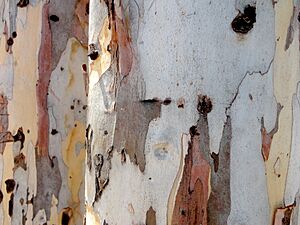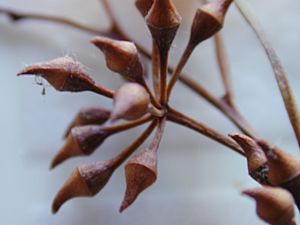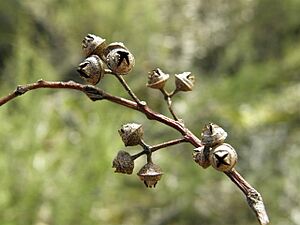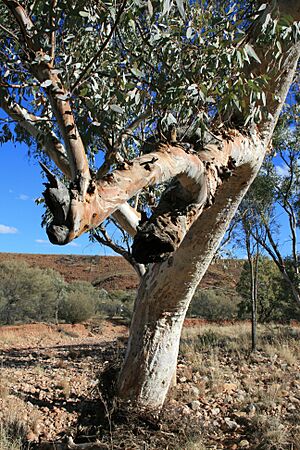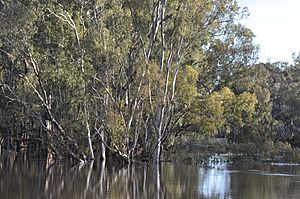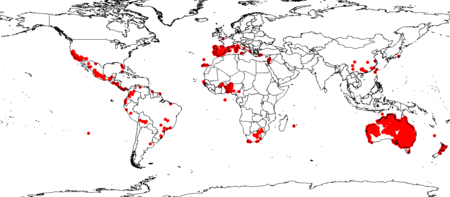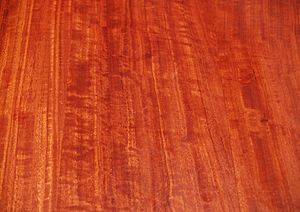River red gum facts for kids
Quick facts for kids River red gum |
|
|---|---|
 |
|
| Eucalyptus camaldulensis in the Wonga Wetlands, NSW | |
| Scientific classification | |
| Genus: |
Eucalyptus
|
| Species: |
camaldulensis
|
The Eucalyptus camaldulensis, also known as the river red gum, is a famous tree found only in Australia. It has smooth bark that is white or cream-coloured. Its leaves are shaped like spears or are slightly curved. The tree produces white flowers in groups of seven or nine. After flowering, it grows round fruit with parts that stick out. This well-known tree often grows along rivers and creeks across inland Australia. It gives much-needed shade in the very hot central parts of the country.
Contents
What is a River Red Gum?
The river red gum is a tree that usually grows about 20 meters (65 feet) tall. Some can even reach 45 meters (148 feet)! Its bark is smooth and can be white, cream, yellow, pink, or brown. Sometimes, you might see rough pieces of bark near the bottom of the tree.
Young leaves are spear-shaped, about 8 to 18 cm (3 to 7 inches) long. Adult leaves are a dull green or grey-green. They are 5 to 30 cm (2 to 12 inches) long.
The tree's flower buds grow in groups of seven, nine, or sometimes eleven. They are oval or round, green to creamy yellow. The flowers are white and mostly bloom in summer. After flowering, the tree produces woody, round fruit.
Important safety tip: Big branches, or even whole river red gum trees, can fall without warning. It's dangerous to camp or picnic too close to them, especially if a tree has dead branches or looks stressed.
How River Red Gums Got Their Name
The scientific name for the river red gum, Eucalyptus camaldulensis, was first officially written down in 1832 by a person named Friedrich Dehnhardt. He described it in a book about a garden in Naples, Italy, called L'Hortus Camaldulensis. The tree's name comes from this garden.
The first tree used to describe the species grew from seeds collected in Australia in 1817. These seeds were gathered near a place called Condobolin by a botanist named Allan Cunningham.
Over time, the tree had a few different names. Other scientists tried to name it, but Dehnhardt's name was the first and eventually became the official one in 1934.
Many Aboriginal groups in the Northern Territory have their own names for this tree. For example, in the Alyawarr and Anmatyerr languages, it's called aper. In the Miriwoong language of the Kimberley region, it's called Dimilan.
Where River Red Gums Grow
The river red gum grows naturally in more places than any other eucalyptus tree. You'll almost always find it near water, like rivers, creeks, or floodplains. Only in a few spots does it grow far from a water source.
Different types, or "subspecies," of river red gums grow in different parts of Australia:
- Some types are found along rivers in Queensland and New South Wales.
- Others grow in dry areas across most mainland states, but only where there's enough water underground.
- The most common type grows along the Murray-Darling river system. It's also the only type found in coastal Victoria.
- Other types are found in places like the Flinders Ranges in South Australia, tropical northern Australia, and along rivers in Western Australia.
River Red Gum Ecology
River red gums love growing along riverbanks and on floodplains. They need regular floods to survive because floods fill the soil with water. They prefer soils that have a lot of clay.
These trees are super important for other plants and animals, especially in dry areas.
- They provide places for fish to breed when rivers flood. This also helps birds that eat fish.
- Fallen branches from river red gums create "snags" in rivers. These snags are vital homes and breeding spots for native fish like river blackfish.
- Old trees form hollows (holes) when they are around 120–180 years old. These hollows become homes for many animals, including bats, pythons, and birds.
- The thick leaves of the tree offer shade and shelter from the sun.
- The superb parrot, a bird that is a threatened species, builds its nests in river red gums.
River red gums also help the environment by dropping leaves and insects, which add nutrients to the soil. This is very important in places where the soil doesn't have many nutrients. Because they grow on floodplains, they also help slow down floods and reduce mud runoff.
River Red Gums as a Weed
Even though river red gums are native to Australia, they can become a problem in other parts of the world. They are listed as a weed in countries like Portugal, South Africa, Spain, and the United States.
They are very good at handling dry weather and salty soil. They also produce many seeds and can reproduce when they are very young. This makes them highly adaptable, but it also means they can spread easily and take over areas where they are not native.
Reproduction and Life Cycle
The river red gum flower starts as a protected bud. A cap, called an operculum, covers the inside of the flower bud while the male and female parts grow.
The male parts, called stamens, have thin stalks and pollen sacs. These sacs open to release pollen. The female parts, called ovaries, are inside chambers. A structure called the stigma extends from the ovaries.
When the flower blooms, pollen can fall onto the stigma. This can lead to self-pollination, but usually, the flower is pollinated by other flowers on the same tree or on different trees. Insects, birds, and small mammals help carry the pollen.
After the flower is pollinated, the fruit develops. It becomes woody and dry. Small, triangular openings in the fruit release the yellow, cube-shaped seeds. Most seeds fall near the tree, but some are carried by wind and water.
Seeds are mostly released in spring and summer. Natural floods happen in winter and spring. While floods can help spread seeds, it seems that good conditions for germination, like damp soil and plenty of sunlight, are more important for new trees to grow. Many seeds are produced, but only a few will grow into new trees, especially if there isn't an open space for them to get enough sunlight.
Barmah Red Gum Forests
The large Barmah red gum forests in Australia were formed because of a geological event that happened about 25,000 years ago. This event involved the Cadell Fault.
River red gum seeds grow easily after floods, and the trees need regular spring floods to survive. However, in the Murray-Darling Basin, floods are now rare because rivers are controlled for irrigation. This means that 75% of river red gums in the lower Murray River area are stressed, dying, or already dead.
The biggest remaining area of river red gums is the Barmah-Millewa forest. It covers about 65,000 hectares (160,000 acres) and is located on the border of Victoria and New South Wales. This forest is very important to the Indigenous Yorta Yorta Nation.
For over 100 years, logging has changed these forests. There are not enough old trees with hollows, which are homes for rare animals like the superb parrot and brush-tailed phascogale. Large logging machines can also damage the soil, which might lead to more weeds and harm rare plants.
The Cadell Fault caused the Murray River to change its path, creating new channels and regularly flooding a large area of low-lying land. These conditions were perfect for river red gums, which quickly grew into the forests we see today.
Uses of River Red Gums
Growing River Red Gums
River red gum seeds sprout easily, even if they've been stored for a while. Young trees quickly become tough and can handle dry conditions. They are also great for making bonsai trees and can regrow from their base or from special buds.
Timber from Red Gums
The wood of the river red gum is famous for its beautiful red colour, which can range from light pink to almost black. It's often used for things that need to resist rot, like fence posts. More recently, it's become popular for making furniture because of its deep red colour and interesting patterns.
The wood is hard and dense. It can be polished nicely and is good for carving. Wood turners also love to use it, especially if the wood is old and well-seasoned.
River red gum wood is also a popular choice for firewood. It makes good charcoal and is used in Brazil for making iron and steel. Bees also use the flowers to make honey.
This tree is one of the most widely planted eucalyptus trees in the world. It's grown in many countries, including Argentina, Brazil, Spain, and the United States.
River red gums are important for farming, the environment, and culture. They provide food and shelter for animals. Culturally, they are an iconic part of Australia. Their leaves have even appeared on Australian stamps!
Managing River Red Gum Populations
River red gums have done well by growing near waterways, which has led to a large population. They are not considered endangered. However, changes to their habitat can harm them and the animals that depend on them.
Two main problems are:
- Grazing: Animals eating or trampling young trees can stop new trees from growing.
- Water regulation: Dams and other controls change when and how much water flows in rivers.
Water regulation means less flooding in winter and spring, which is when river red gums release their seeds. This can make it harder for seeds to spread by water. Also, if areas are constantly flooded or don't get enough floods, seeds can't sprout, and existing trees can become unhealthy or die.
Not enough flooding on floodplains means the soil doesn't get enough water, which the trees need. This can lead to stunted growth and poor conditions for new seeds. It also means less habitat for animals that rely on these trees. Some species have already disappeared from river red gum habitats in the Murray-Darling area.
Since the 1980s, people have realized that better water management is needed to protect river red gum habitats. This includes making sure forests get enough water at the right times of the year.
Famous River Red Gums
Here are some well-known river red gums:
- The Big Tree near Moulamein - One of the largest river red gums in the Riverina, with a huge trunk circumference of 11.6 meters (38 feet).
- Cazneaux Tree - Made famous by a photograph called Spirit of Endurance by Harold Cazneaux.
- Separation Tree - This tree was the site of celebrations when Victoria became a separate colony from New South Wales.
- The Old Gum Tree - The colony of South Australia was officially announced under this tree.
- The Queen's Tree - Planted in Kings Park, Perth, Western Australia, in 1954 by Queen Elizabeth II during her first visit to Australia.
Galleries
- Examples of river red gums
-
A river red gum near Bolin Bolin Billabong on the Yarra River.
-
Many river red gums on the banks of the Barcoo River, south-west Queensland.
-
The Cazneaux Tree, near Wilpena Pound in Flinders Ranges National Park
Images for kids
-
A river red gum in a bend of the Murrumbidgee River near Hay, NSW.
See also
 In Spanish: Eucalipto colorado para niños
In Spanish: Eucalipto colorado para niños


